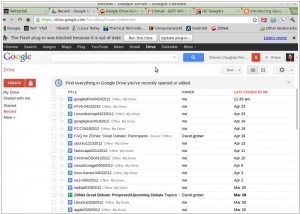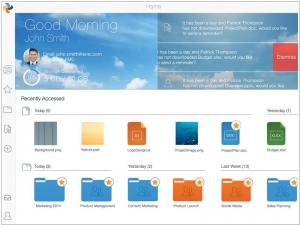Google Drive vs Syncplicity
March 15, 2025 | Author: Michael Stromann
29★
Online file storage and syncing service working as a file system for other Google's services. Allows to sync files between all your computers and mobile devices or collaborate on files with your team and partners. Version control, OCR, powerful online viewer. Provides 5 GB free disk space.
1★
Syncplicity delivers powerful, easy to use file management in the cloud. Syncplicity automatically syncs your files across all your computers, backs up your data, and makes sharing files and collaborating easier than ever before.
See also:
Top 10 Cloud Storages for business
Top 10 Cloud Storages for business
Google Drive and Syncplicity, though designed to keep your digital files from collapsing into chaotic oblivion, share a surprising amount in common. Both services offer cloud-based file storage and syncing, ensuring your important documents never suffer the cruel fate of being left behind on a device. They also allow real-time collaboration, making sure that when someone types a truly profound insight into a shared document, everyone else gets to see it, without delay. If you’re on the go, both have mobile apps for those peculiar moments when you’re desperate to review a spreadsheet while waiting for your coffee.
Now, let’s talk about Google Drive, which first appeared in 2012, probably around the time humans decided that digital documents should be accessible everywhere, even in the middle of a forest. It’s based in the United States, that curious land of oversized everything and offers a 15 GB free storage plan to any passing intergalactic traveler. Ideal for individuals, small businesses or anyone who just needs a simple place to stash their files without drowning in technical jargon. It's beautifully integrated with the other services from the Google universe, so if you’re already addicted to Gmail, Docs or Sheets, Drive will happily pull them all into orbit around each other, making your digital life easier to navigate.
Syncplicity, on the other hand, has been roaming the cloud since 2008 and is particularly fond of large businesses and enterprises that need a little more control over their data. Unlike Google’s cheerful and somewhat casual approach to file storage, Syncplicity is designed for people who want robust administrative control, the sort that might make a corporate IT officer feel both important and slightly ominous. It also prides itself on being the reliable, secure companion for those businesses that insist on having their data safely encrypted and compliant with every imaginable regulation. It’s a little more like a spaceship than a commuter bus, catering to the need for power, scalability and the occasional inter-office espionage.
See also: Top 10 Cloud Storages
Now, let’s talk about Google Drive, which first appeared in 2012, probably around the time humans decided that digital documents should be accessible everywhere, even in the middle of a forest. It’s based in the United States, that curious land of oversized everything and offers a 15 GB free storage plan to any passing intergalactic traveler. Ideal for individuals, small businesses or anyone who just needs a simple place to stash their files without drowning in technical jargon. It's beautifully integrated with the other services from the Google universe, so if you’re already addicted to Gmail, Docs or Sheets, Drive will happily pull them all into orbit around each other, making your digital life easier to navigate.
Syncplicity, on the other hand, has been roaming the cloud since 2008 and is particularly fond of large businesses and enterprises that need a little more control over their data. Unlike Google’s cheerful and somewhat casual approach to file storage, Syncplicity is designed for people who want robust administrative control, the sort that might make a corporate IT officer feel both important and slightly ominous. It also prides itself on being the reliable, secure companion for those businesses that insist on having their data safely encrypted and compliant with every imaginable regulation. It’s a little more like a spaceship than a commuter bus, catering to the need for power, scalability and the occasional inter-office espionage.
See also: Top 10 Cloud Storages





